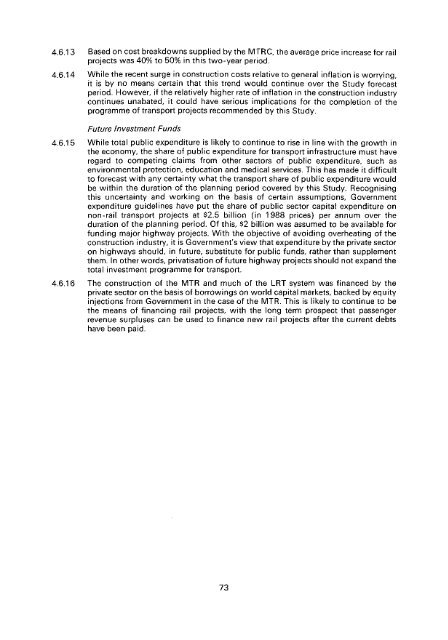Untitled - HKU Libraries - The University of Hong Kong
Untitled - HKU Libraries - The University of Hong Kong
Untitled - HKU Libraries - The University of Hong Kong
- No tags were found...
You also want an ePaper? Increase the reach of your titles
YUMPU automatically turns print PDFs into web optimized ePapers that Google loves.
4.6.13 Based on cost breakdowns supplied by the MTRC, the average price increase for railprojects was 40% to 50% in this two-year period.4.6.14 While the recent surge in construction costs relative to general inflation is worrying,it is by no means certain that this trend would continue over the Study forecastperiod. However, if the relatively higher rate <strong>of</strong> inflation in the construction industry. continues unabated, it could have serious implications for the completion <strong>of</strong> theprogramme <strong>of</strong> transport projects recommended by this Study.Future Investment Funds4.6.15 While total public expenditure is likely to continue to rise in line with the growth inthe economy, the share <strong>of</strong> public expenditure for transport infrastructure must haveregard to competing claims from other sectors <strong>of</strong> public expenditure, such asenvironmental protection, education and medical services. This has made it difficultto forecast with any certainty what the transport share <strong>of</strong> public expenditure wouldbe within the duration <strong>of</strong> the planning period covered by this Study. Recognisingthis uncertainty and working on the basis <strong>of</strong> certain assumptions, Governmentexpenditure guidelines have put the share <strong>of</strong> public sector capital expenditure onnon-rail transport projects at $2.5 billion (in 1988 prices) per annum over theduration <strong>of</strong> the planning period. Of this, $2 billion was assumed to be available forfunding major highway projects. With the objective <strong>of</strong> avoiding overheating <strong>of</strong> theconstruction industry, it is Government's view that expenditure by the private sectoron highways should, in future, substitute for public funds, rather than supplementthem. In other words, privatisation <strong>of</strong> future highway projects should not expand thetotal investment programme for transport.4.6.16 <strong>The</strong> construction <strong>of</strong> the MTR and much <strong>of</strong> the LRT system was financed by theprivate sector on the basis <strong>of</strong> borrowings on world capital markets, backed by equityinjections from Government in the case <strong>of</strong> the MTR. This is likely to continue to bethe means <strong>of</strong> financing rail projects, with the long term prospect that passengerrevenue surpluses can be used to finance new rail projects after the current debtshave been paid.73
















